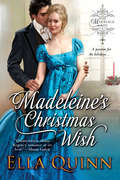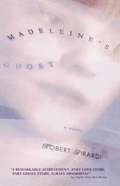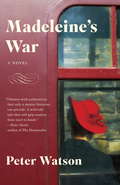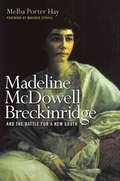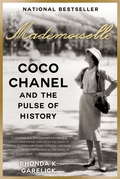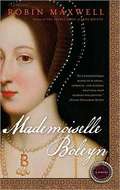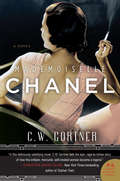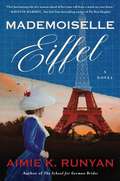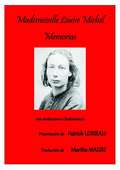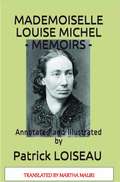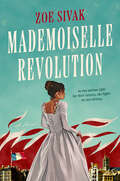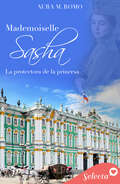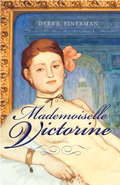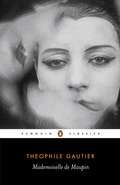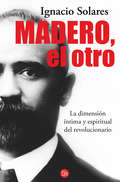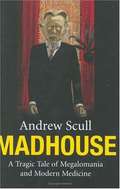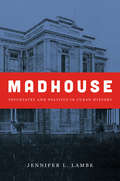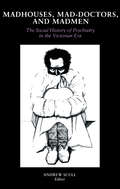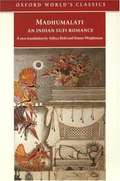- Table View
- List View
Madeleine Takes Command (Living History Library)
by Ethel C. BrillWORKING with feverish haste, Madeleine selected muskets, pistols, powder and bullets. The sight of a man's hat, an old one that had belonged to her father, lying on a powder cask, gave her an idea. She pulled off her linen cap and put on the hat. It was not too large over her heavy hair, and, seen above the pickets, it would deceive the Indians. She was adjusting powder horn and bullet pouch when Louis and Alexandre ran in with Laviolette at their heels."Arm yourselves quickly," Madeleine ordered."What is your plan, Ma'm'selle?" the old soldier inquired."To defend the seigneury to the last. The little children must stay in the blockhouse and their mothers with them. That leaves only six of us to guard the palisades. We must try to make the Mohawks believe that we have a strong garrison. If they attack, we can only do our best. We are fighting for our people--what there are left of them--for our country and our faith. Let us fight to the death if need be."AND SO MADELEINE and her small force begin their harrowing vigil--hoping against all hope that help will come in time.
Madeleine's Christmas Wish (The Marriage Game)
by Ella QuinnThe bachelors in Ella Quinn's Marriage Game series make a habit of resisting the irresistible. But during the season for giving, surrendering to temptation may be the greatest gift of all...A French spy, Georges, Marquis Cruzy-le-Châtel, has lived in England for years, sacrificing his life for his country--but not his heart. For he's never been able to forget his childhood friend, Madeleine. And now, in her hour of need, he is there to rescue her...The victim of a ruthless statesman, Madeleine, Comtesse du Beaune, has been abducted and sent to England to work in a brothel. Her greatest wish is to return home for Christmas, and her only hope of it is to marry Georges--though she will be his wife in name alone. Yet as they steal across the snowy countryside, Georges decides to woo her--with kisses that melt the winter's frost and leave her longing for a holiday miracle...
Madeleine's Ghost
by Robert GirardiBrooklyn needs a saint. Ned Conti needs a stipend. So the struggling young historian agrees to trace the mysterious past of a Brooklyn nun for evidence of miracles. Trapped in a neighborhood of cheap rents and failed promise, in a rent-controlled apartment suddenly, inexplicably seized by a beautiful and angry ghost, Ned's only refuge is the F train to Manhattan's East Village bars, where he and his friends drown their sorrows in drink....But Ned is about to heed another call, the siren song of New Orleans, where the history of countless lost souls seems to rise from the steaming streets--and where, ten years before, he ended a brief, passionate affair with a woman whose memory has haunted him ever since. Here, in a city of spirits, Ned will embrace a dead saint and a living sinner...as a beautiful ghost offers him her desire. And his destiny....Set amid the sleepless energy and seething passion of New York and New Orleans, Madeleine's Ghost is a spellbinding novel of lost love, history, and desire--a work of startling originality that is at once exquisitely written and compulsively readable.
Madeleine's War
by Peter WatsonA compulsively readable blend of romance and drama based on actual events in Britain and France leading up to D-Day in 1944 Matthew Hammond is a British military officer posted to the European theater during World War II. He sustained a serious injury on the front lines, so bad, in fact, that it cost him a lung. Now he is back in England, unable to fight, but he continues to serve his country by training new resistance fighters. One of the recruits under his tutelage is Madeleine, a spellbinding, impassioned French-Canadian with eyes of "burnished whiskey." Despite protocols discouraging romance, they are deeply in love, and Matthew is torn about putting Madeleine's life in danger. He already has one tragic affair with a Resistance fighter under his belt--his former lover, Celestine, was killed because her assassination of a German doctor went awry. But the Allies are mustering all their resources for crucial beach landings in Normandy, and Matthew knows his unit will need to play a role. It will be a very dangerous mission: parachuting in behind the Nazi line. As Madeleine progresses through the training with her fellow recruits, Matthew can only hope that luck will guide her through when the drop finally arrives.
Madeline McDowell Breckinridge and the Battle for a New South (Topics in Kentucky History)
by Melba Porter HayA biography of the Kentucky women’s rights activist and progressive reformer, featuring personal interviews and recently discovered correspondence.Preeminent Kentucky reformer and women’s rights advocate Madeline McDowell Breckinridge (1872-1920) was at the forefront of social change during the late nineteenth and early twentieth centuries. A descendant of Henry Clay and the daughter of two of Kentucky’s most prominent families, Breckinridge had a remarkably varied activist career that included roles in the promotion of public health, education, women’s rights, and charity. Founder of the Lexington Civic League and Associated Charities, Breckinridge successfully lobbied to create parks and playgrounds and to establish a juvenile court system in Kentucky. She also became president of the Kentucky Equal Rights Association, served as vice president of the National American Woman Suffrage Association, and even campaigned across the country for the League of Nations.In the first biography of Breckinridge since 1921, Melba Porter Hay draws on newly discovered correspondence and rich personal interviews with her female associates to illuminate the fascinating life of this important Kentucky activist. Deftly balancing Breckinridge’s public reform efforts with her private concerns, Hay tells the story of Madeline’s marriage to Desha Breckinridge, editor of the Lexington Herald, and how she used the match to her advantage by promoting social causes in the newspaper. Hay also chronicles Breckinridge’s ordeals with tuberculosis and amputation, and emotionally trying episodes of family betrayal and sex scandals. Hay describes how Breckinridge’s physical struggles and personal losses transformed her from a privileged socialite into a selfless advocate for the disadvantaged. Later as vice president of the National American Women Suffrage Association, Breckinridge lobbied for Kentucky’s ratification of the Nineteenth Amendment, which gave women the right to vote in 1920. While devoting much of her life to the woman suffrage movement on the local and national levels, she also supported the antituberculosis movement, social programs for the poor, compulsory school attendance, and laws regulating child labor.In bringing to life this extraordinary reformer, Hay shows how Breckinridge championed Kentucky’s social development during the Progressive Era.Praise for Madeline McDowell Breckinridge and the Battle for a New South“An important contribution to American history, one that is of special significance to Kentucky history, the Progressive Era, and the women's rights movement.” —Paul Fuller, author of Laura Clay and the Women’s Rights Movement“Hay brings to life a multi-dimensional woman, emblematic of her times, with whom readers can identify and sympathize.” —Melanie Beals Goan, author of Mary Breckinridge: The Frontier Nursing Service and Rural Health in Appalachia
Mademoiselle
by Rhonda K. GarelickCertain lives are at once so exceptional, and yet so in step with their historical moments, that they illuminate cultural forces far beyond the scope of a single person. Such is the case with Coco Chanel, whose life offers one of the most fascinating tales of the twentieth century--throwing into dramatic relief an era of war, fashion, ardent nationalism, and earth-shaking change--here brilliantly treated, for the first time, with wide-ranging and incisive historical scrutiny. Coco Chanel transformed forever the way women dressed. Her influence remains so pervasive that to this day we can see her afterimage a dozen times while just walking down a single street: in all the little black dresses, flat shoes, costume jewelry, cardigan sweaters, and tortoiseshell eyeglasses on women of every age and background. A bottle of Chanel No. 5 perfume is sold every three seconds. Arguably, no other individual has had a deeper impact on the visual aesthetic of the world. But how did a poor orphan become a global icon of both luxury and everyday style? How did she develop such vast, undying influence? And what does our ongoing love of all things Chanel tell us about ourselves? These are the mysteries that Rhonda K. Garelick unravels in Mademoiselle. Raised in rural poverty and orphaned early, the young Chanel supported herself as best she could. Then, as an uneducated nineteen-year-old café singer, she attracted the attention of a wealthy and powerful admirer and parlayed his support into her own hat design business. For the rest of Chanel's life, the professional, personal, and political were interwoven; her lovers included diplomat Boy Capel; composer Igor Stravinsky; Romanov heir Grand Duke Dmitri; Hugh Grosvenor, the Duke of Westminster; poet Pierre Reverdy; a Nazi officer; and several women as well. For all that, she was profoundly alone, her romantic life relentlessly plagued by abandonment and tragedy. Chanel's ambitions and accomplishments were unparalleled. Her hat shop evolved into a clothing empire. She became a noted theatrical and film costume designer, collaborating with the likes of Pablo Picasso, Jean Cocteau, and Luchino Visconti. The genius of Coco Chanel, Garelick shows, lay in the way she absorbed the zeitgeist, reflecting it back to the world in her designs and in what Garelick calls "wearable personality"--the irresistible and contagious style infused with both world history and Chanel's nearly unbelievable life saga. By age forty, Chanel had become a multimillionaire and a household name, and her Chanel Corporation is still the highest-earning privately owned luxury goods manufacturer in the world. In Mademoiselle, Garelick delivers the most probing, well-researched, and insightful biography to date on this seemingly familiar but endlessly surprising figure--a work that is truly both a heady intellectual study and a literary page-turner.Advance praise for Mademoiselle "This is the definitive biography of Chanel. It is also the life of one of the most successful world conquerors who has ever imposed her will on a vast subject population. It is gripping, astute, and elegantly written. And if it leaves you leery of ever wearing a Chanel jacket, or carrying a Chanel bag, you will understand where the desire for it came from."--Judith Thurman, author of the National Book Award-winning Isak Dinesen: The Life of a Storyteller "In this magisterial, affecting portrait, Rhonda K. Garelick traces Chanel's history as a woman and as a designer and in doing so illuminates the troubling contradictions of twentieth-century Europe."--Andrew Solomon, author of the National Book Award-winning The Noonday DemonFrom the Hardcover edition.
Mademoiselle Boleyn
by Robin MaxwellWhen her father is assigned the task of spying on the French Court, the charming and sweetly innocent Anne Boleyn is delighted by the thought of a new adventure. And she is not to be disappointed, for her beautiful sister, Mary, has been handed a mission: to let herself be seduced by the King of France in order to uncover his secrets. Mesmerized by the thrilling passion, intrigue, and betrayal that unfolds, Anne discovers the power of being a woman who catches the eye of a powerful king. And, as she grows into a beautiful young woman, she undergoes her own sexual awakening, each daring exploit taking her one step closer to the life that is her destiny. .
Mademoiselle Chanel
by C. W. GortnerShe revolutionized fashion and built an international empire . . . all on her own termsBorn into rural poverty, Gabrielle Chanel and her sisters are sent to a convent orphanage after their mother's death. The nuns of the order nurture Gabrielle's exceptional sewing skills, a talent that would propel the willful young woman into a life far removed from the drudgery of her childhood.Burning with ambition, the petite brunette transforms herself into Coco, by day a hard-working seamstress and by night a singer in a nightclub, where her incandescence draws in a wealthy gentleman who becomes the love of her life. She immerses herself in his world of money and luxury, discovering a freedom that sparks her creativity. But it is only when her lover takes her to Paris that Coco discovers her destiny. Rejecting the frilly, corseted silhouette of the past, Coco's sleek, minimalist styles reflect the youthful ease and confidence of the 1920s modern woman. As her reputation spreads, her couture business explodes, taking her into rarefied circles of society and bohemian salons. But her fame and fortune cannot save her from heartbreak as the years pass. And when Paris falls to the Nazis, Coco is forced to make choices that will haunt her always. An enthralling novel about an entirely self-made woman, Mademoiselle Chanel tells the true story of Coco Chanel's extraordinary ambition, passion, and artistic vision.
Mademoiselle Eiffel: A Novel
by Aimie K. RunyanFrom the author of The School for German Brides and A Bakery in Paris, this captivating historical novel set in nineteenth-century Paris tells the story of Claire Eiffel, a woman who played a significant role in maintaining her family’s legacy and their iconic contributions to the city of Paris.Claire Eiffel, the beautiful, brilliant eldest daughter of the illustrious architect Gustave Eiffel, is doted upon with an education envied by many sons of the upper classes, and entirely out of the reach of most daughters. Claire’s idyllic childhood ends abruptly when, at fourteen, her mother passes away. It’s soon made clear that Gustave expects Claire to fill her mother’s place as caregiver to the younger children and as manager of their home.As she proves her competence, Claire’s importance to her father grows. She accompanies him on his travels and becomes his confidante and private secretary. She learns her father’s architectural trade and becomes indispensable to his work. But when his bright young protégé, Adolphe Salles, takes up more of Gustave’s time, Claire resents being pushed aside.Slowly, the animosity between Claire and Adolphe turns to friendship…and then to something more. After their marriage in 1885 preserves the Eiffel legacy, they are privileged by the biggest commission of Eiffel’s career: a great iron tower dominating the 1889 World’s Fair to demonstrate the leading role of Paris in the world of art and architecture. Now hostess to the scientific elite, such as Thomas Edison, Claire is under the watchful eye not only of her family and father’s circle, but also the world.When Gustave Eiffel’s involvement in a disastrous endeavor to build a canal in Panama ends in his imprisonment, it is up to Claire to secure her father’s freedom but also preserve the hard-won family legacy.Claire Eiffel’s story of love, devotion, and the frantic pursuit to preserve her family’s legacy is not only an inspired reflection of real personages and historical events, but a hymn to the iconic tower that dominates the City of Lights.
Mademoiselle Louise Michel - Memorias: Con anotaciones y ilustraciones
by Patrick LoiseauA finales de 2018, cuando la inventiva autoritaria, el sentido común, la regresión intelectual y social están a la orden y en aumento con los quinquenios de Sarkozy, Hollande y Macron, los verdaderos progresistas, es decir, los sindicalistas y los revolucionarios, como enemigos a ser eliminados, al menos en términos de moral y palabra, es urgente hacer frente a este intento de sofocar ideológicamente los retratos de esos o aquellos que nos mostraron la manera de hacer de nuestra sociedad algo más que un mercado financiero o un estado feudal. Mademoiselle Louise Michel es uno de estos personajes extraordinarios. La llamo Mademoiselle por respeto, como lo hizo su editorial en 1886, y también para recordar que Louise Michel no solo era una persona revolucionaria, ciertamente, sino también una mujer sensible y atractiva como lo habría dicho ella misma: "No lo merezco, ya que sigo mi instinto como todos los seres y como todas las cosas, pero tampoco soy un monstruo. Todos somos producto de nuestro tiempo, eso es todo. Cada uno de nosotros tiene sus cualidades y sus defectos; es el derecho consuetudinario; pero no importa lo que seamos, si nuestro trabajo es excelente y nos cubre con su luz; no se trata de lo que nosotros iniciamos, sino lo que será para la humanidad cuando nos hayamos ido." ...
Mademoiselle Louise Michel: Memoirs - Annotated and Illustrated
by Patrick LoiseauAt the end of 2018, with the invective, common sense, intellectual and social authoritarian regression under way increasingly identified with the five-year period of Sarkozy, Hollande and Macron, the real progressives, that is to say, trade unionists and revolutionaries, as enemies to be defeated, -at least in regard to morality and expression-, it is urgent to face this attempt to ideologically crush the portraits of those who have shown us the way to make our society other than a financial market or a feudal state. Mademoiselle Louise Michel is one of these extraordinary characters. I call her Mademoiselle - as her publisher did in 1886 - out of respect and to keep in mind as well the common observation that Louise Michel was not a revolutionary, certainly but also a sensitive and engaging person who said of herself: "I do not deserve it, since I follow my inclinations like all beings and all things do, but I am not a monster either. We are all the product of our times, that's all. Each of us has his qualities and defects, it is the common law, but no matter what we are, if our work is great and covers us with its light; it's not about us in what we start, it's about what will leave for humanity when we are gone. " ...
Mademoiselle Revolution
by Zoe SivakA powerful, engrossing story of a biracial heiress who escapes to Paris when the Haitian Revolution burns across her island home. But as she works her way into the inner circle of Robespierre and his mistress, she learns that not even oceans can stop the flames of revolution. Sylvie de Rosiers, as the daughter of a rich planter and an enslaved woman, enjoys the comforts of a lady in 1791 Saint-Domingue society. But while she was born to privilege, she was never fully accepted by island elites. After a violent rebellion begins the Haitian Revolution, Sylvie and her brother leave their family and old lives behind to flee unwittingly into another uprising—in austere and radical Paris. Sylvie quickly becomes enamored with the aims of the Revolution, as well as with the revolutionaries themselves—most notably Maximilien Robespierre and his mistress, Cornélie Duplay. As a rising leader and abolitionist, Robespierre sees an opportunity to exploit Sylvie&’s race and abandonment of her aristocratic roots as an example of his ideals, while the strong-willed Cornélie offers Sylvie safe harbor and guidance in free thought. Sylvie battles with her past complicity in a slave society and her future within this new world order as she finds herself increasingly torn between Robespierre's ideology and Cornélie's love. When the Reign of Terror descends, Sylvie must decide whether to become an accomplice while a new empire rises on the bones of innocents…or risk losing her head.
Mademoiselle Sasha: La protectora de la princesa
by Aura M. Romo¿Se atreverá a amar o dejará pasar la oportunidad que le ofrece la vida? Sasha Shuvalovich ha sido criada como un muchacho desde su nacimiento para ocupar el puesto de General Polkóvnik y Protectora de la Princesa María Romanov. Pero tendrá que sortear problemas por ser mujer, envidias y su desprecio por los sentimientos, contrastado por el gran amor que siente por su Patria. Sin embargo, cuando se le informa de que el príncipe Sergei Petrescu de Moscú, el pretendiente de la princesa, arribará al Palacio de Invierno, comienza a tener sentimientos encontrados. Definitivamente, no puede enamorarse del futuro esposo de su protegida. ¿Qué es más importante, el puesto para el que ha sido criada desde niña o el amor que ha tocado a su puerta de manera inesperada?
Mademoiselle Victorine
by Debra FinermanWhen Victorine Laurent joins the chorus of the grand Paris Opera ballet, she expects to become the mistress of a wealthy man; this is how young women without family survive in the decadent City of Light. Yet when the artist Degas introduces her to Edouard Manet, her life changes dramatically. She agrees to pose for him, and the result is a painting that shocks Paris. Overnight, Victorine becomes the city’s most sought after courtesan. When she becomes the favorite of the Duke de Lyon, the power behind the shaky government of Emperor Louis-Napoléon, her continued attraction to Manet becomes dangerous for them both. And when an astonishing secret from Victorine’s past comes to light, her carefully constructed world may come crashing down around her. Mademoiselle Victorinetransports readers back to nineteenth-century Paris, a time when art, love, and commerce blended seamlessly together. From the Trade Paperback edition.
Mademoiselle de Maupin
by Theophile GautierChevalier d'Albert fantasizes about his ideal lover, yet every woman he meets falls short of his exacting standards of female perfection. Embarking on an affair with the lovely Rosette to ease his boredom, he is thrown into tumultuous confusion when she receives a dashing young visitor. Exquisitely handsome, Théodore inspires passions d'Albert never believed he could feel for a man - and Rosette also seems to be in thrall to the charms of her guest. Does this bafflingly alluring person have a secret to hide? Subversive and seductive, Mademoiselle de Maupin (1835) draws readers into the bedrooms and boudoirs of a French château in a compelling exploration of desire and sexual intrigue.
Madero, el otro
by Ignacio SolaresLa dimensión íntima y espiritual del revolucionario En esta novela, Ignacio Solares reconstruye la vida de Francisco I. Madero, el hombre que se opuso a la dictadura de Porfirio Díaz y proclamó la no reelección, iniciando la revolución mexicana. Para ello, elige una veta poco explorada: las creencias místicas y religiosas del personaje histórico, sus sueños y sus inclinaciones al espiritismo; su constante comunicación con las almas que lo predestinaban a ocupar un lugar de líder y mártir frente a su patria. La narración comienza con la muerte de Madero en la Decena Trágica y, desde ahí, se interna en los episodios claves que lo llevaron hasta ese momento crítico: sus debilidades ante el usurpador Victoriano Huerta, su interés por mediar intereses irreconciliables, las dudas que lo apartaron de sus aliados, como Zapata, y favorecieron a sus enemigos, a los que se empeñaba en perdonar, pese a las advertencias de todos... Solares se adentra al mundo emocional y psicológico del llamado "apóstol" con gran exactitud, ya que tuvo acceso a los apuntes personales de Madero. Por ello logra caracterizar al personaje con fidelidad, mediante un estilo certero, verosímil y una fascinante reconstrucción de hechos que conmocionaron la vida del país.
Madhouse at the End of the Earth: The Belgica's Journey into the Dark Antarctic Night
by Julian SanctonIn August 1897, the young Belgian commandant Adrien de Gerlache set sail for a three-year expedition aboard the good ship Belgica with dreams of glory. His destination was the uncharted end of the earth: the icy continent of Antarctica. <p><p> But de Gerlache’s plans to be first to the magnetic South Pole would swiftly go awry. After a series of costly setbacks, the commandant faced two bad options: turn back in defeat and spare his men the devastating Antarctic winter, or recklessly chase fame by sailing deeper into the freezing waters. De Gerlache sailed on, and soon the Belgica was stuck fast in the icy hold of the Bellingshausen Sea. When the sun set on the magnificent polar landscape one last time, the ship’s occupants were condemned to months of endless night. In the darkness, plagued by a mysterious illness and besieged by monotony, they descended into madness. <p><p> In Madhouse at the End of the Earth, Julian Sancton unfolds an epic story of adventure and horror for the ages. As the Belgica’s men teetered on the brink, de Gerlache relied increasingly on two young officers whose friendship had blossomed in captivity: the expedition’s lone American, Dr. Frederick Cook—half genius, half con man—whose later infamy would overshadow his brilliance on the Belgica; and the ship’s first mate, soon-to-be legendary Roald Amundsen, even in his youth the storybook picture of a sailor. Together, they would plan a last-ditch, nearly certain-to-fail escape from the ice—one that would either etch their names in history or doom them to a terrible fate at the ocean’s bottom. <p><p> Drawing on the diaries and journals of the Belgica’s crew and with exclusive access to the ship’s logbook, Sancton brings novelistic flair to a story of human extremes, one so remarkable that even today NASA studies it for research on isolation for future missions to Mars. Equal parts maritime thriller and gothic horror, Madhouse at the End of the Earth is an unforgettable journey into the deep. <p> <b>New York Times Bestseller</b>
Madhouse: A Tragic Tale of Megalomania and Modern Medicine
by Andrew ScullMadhouse reveals a long-suppressed medical scandal, shocking in its brutality and sobering in its implications. It shows how a leading American psychiatrist of the early twentieth century came to believe that mental illnesses were the product of chronic infections that poisoned the brain. Convinced that he had uncovered the single source of psychosis, Henry Cotton, superintendent of the Trenton State Hospital, New Jersey, launched a ruthless campaign to "eliminate the perils of pus infection." Teeth were pulled, tonsils excised, and stomachs, spleens, colons, and uteruses were all sacrificed in the assault on "focal sepsis." Many patients did not survive Cotton's surgeries; thousands more were left mangled and maimed. Cotton's work was controversial, yet none of his colleagues questioned his experimental practices. Subsequent historians and psychiatrists too have ignored the events that cast doubt on their favorite narratives of scientific and humanitarian progress. In a remarkable feat of historical detective work, Andrew Scull exposes the full, frightening story of madness among the mad-doctors. Drawing on a wealth of documents and interviews, he reconstructs in vivid detail a nightmarish, cautionary chapter in modern psychiatry when professionals failed to police themselves.
Madhouse: Psychiatry and Politics in Cuban History (Envisioning Cuba)
by Jennifer L. LambeOn the outskirts of Havana lies Mazorra, an asylum known to--and at times feared by--ordinary Cubans for over a century. Since its founding in 1857, the island's first psychiatric hospital has been an object of persistent political attention. Drawing on hospital documents and government records, as well as the popular press, photographs, and oral histories, Jennifer L. Lambe charts the connections between the inner workings of this notorious institution and the highest echelons of Cuban politics. Across the sweep of modern Cuban history, she finds, Mazorra has served as both laboratory and microcosm of the Cuban state: the asylum is an icon of its ignominious colonial and neocolonial past and a crucible of its republican and revolutionary futures.From its birth, Cuban psychiatry was politically inflected, drawing partisan contention while sparking debates over race, religion, gender, and sexuality. Psychiatric notions were even invested with revolutionary significance after 1959, as the new government undertook ambitious schemes for social reeducation. But Mazorra was not the exclusive province of government officials and professionalizing psychiatrists. U.S. occupiers, Soviet visitors, and, above all, ordinary Cubans infused the institution, both literal and metaphorical, with their own fears, dreams, and alternative meanings. Together, their voices comprise the madhouse that, as Lambe argues, haunts the revolutionary trajectory of Cuban history.
Madhouses, Mad-Doctors, and Madmen
by Andrew ScullThe Victorian Age saw the transformation of the madhouse into the asylum into the mental hospital; of the mad-doctor into the alienist into the psychiatrist; and of the madman (and madwoman) into the mental patient. In Andrew Scull's edited collection Madhouses, Mad-Doctors, and Madmen, contributors' essays offer a historical analysis of the issues that continue to plague the psychiatric profession today. Topics covered include the debate over the effectiveness of institutional or community treatment, the boundary between insanity and criminal responsibility, the implementation of commitment laws, and the differences in defining and treating mental illness based on the gender of the patient.
Madhrate Aazadi
by Gopaldas Pateદેશ આઝાદ થવાની તૈયારીમાં હતો ત્યારની વર્ષ 1947ની—સ્વાતંત્ર્ય ચળવળ અને લૉર્ડ માઉન્ટબૅટનની ભારતના ગવર્નરજનરલ તરીકેની વરણીથી લઈને ગાંધીજીના અંતિમ સંસ્કાર સુધીના ખાસ્સા સંઘર્ષ પીડા—કરુણામય સમયને આવરીને બે ફ્રેન્ચ લેખકો લૅરી કોલિન્સ અને ડૉમિનિક લાપિયેરે લખેલા અંગ્રેજી પુસ્તક ‘ફ્રીડમ ઍટ મિડનાઇટ’નો ગોપાલદાસ પટેલે કરેલો સંક્ષિપ્ત અનુવાદ છે. હિંદુસ્તાનના ભાગલા, સ્વતંત્ર અને સાર્વભૌમ ભારત રાષ્ટ્રનો જન્મ અને ગાંધીજીની હત્યા સંબંધે સરેરાશ ભારતવાસીમાં જે માહિતી-સમજણ પ્રવર્તે છે, તેમાં ખાસ્સા સુધારાનો અવકાશ ધરાવતું આ પુસ્તક નવી પેઢી માટે ઇતિહાસને ખુલ્લા મને જોવા સમજવા માટેની દૃષ્ટિ ખીલવનારું બની રહેશે.
Madhughat: मधुघट
by Govind Talwalkarगोविंद तळवलकर यांची "मधुघट" ही साहित्य, कला आणि वैचारिक चिंतन यांचा एक सुंदर संग्रह आहे. या पुस्तकात एकूण १४ लेख आहेत, जे जगभरातील महान साहित्यिक व त्यांच्या कलेच्या प्रभावावर आधारित आहेत. शेक्सपिअर, टॉलस्टॉय, रवींद्रनाथ टागोर यांसारख्या दिग्गजांच्या जीवन व त्यांच्या कलेचे वैविध्यपूर्ण पैलू तळवलकरांनी उलगडले आहेत. शेक्सपिअरला ते "जगाचा नागरिक" म्हणतात, कारण त्याचे साहित्य काल आणि प्रदेश यांच्या मर्यादा ओलांडून आजही जागतिक पातळीवर आदराने वाचले जाते. या पुस्तकात टॉलस्टॉयच्या साहित्याची तुलना, डॉ. झिवागोच्या ऐतिहासिक पार्श्वभूमीचा उलगडा आणि शेक्सपिअरच्या घराच्या भेटीचा अनुभव अशा अनेक गोष्टींचा समावेश आहे. तळवलकरांच्या लेखनातून साहित्याच्या विविध अंगांबद्दल खोलवर माहिती मिळते. साहित्य आणि कलेमधील सौंदर्य, त्यामागील वैचारिक मंथन, आणि मानवी स्वभावाच्या गूढतेचा शोध घेण्याचा प्रयत्न त्यांच्या लिखाणातून दिसतो. "मधुघट" मध्ये साहित्य आणि कलाकृतींचा आस्वाद घेताना एकत्र विचारमंथन करण्याचा आनंद वाचकांना मिळतो. शेक्सपिअरच्या नाटकांतील पात्रांचे मानसशास्त्र, त्यातील कालातीत संदर्भ, आणि त्यांच्या भाषेचे सौंदर्य लेखकाने रसपूर्ण शैलीत मांडले आहे. तळवलकरांचे लिखाण सहज आणि प्रभावी असून, ते वाचकांना ज्ञानाच्या व्यापक व साहित्याच्या गोड प्रवासात नेते.
Madhumalati
by Aditya Behl Simon Weightman Mir Sayyid Manjhan Shattari RajgiriThe mystical romance Madhumalati tells the story of a prince, Manohar, and his love for the beautiful princess Madhumalati. When they are separated they have to endure suffering, adventure, and transformation before they can be reunited and experience true happiness. A delightful love story,the poem is also rich in mystical symbolism and the story of the two lovers represents the stages on the spiritual path to enlightenment. Madhumalati was written in the sixteenth century and it is an outstanding example of Sufi literature in the Indian Islamic tradition. Originally written in adialect of Eastern Hindi it is here translated for the first time into English verse, with an introduction and notes that explain the poem's religious significance.
Madhyakalin Bharat Rajniti, Samaj Aur Sanskriti - Ranchi University, N.P.U: मध्यकालीन भारत राजनीति, समाज और संस्कृति - राँची यूनिवर्सिटी, एन.पी.यू.
by Satish Chandraमध्यकालीन भारत राजनीति, समाज और संस्कृति यह पुस्तक इतिहास के काल का वर्णन प्रस्तुत करती है, प्रस्तुत पुस्तक में विस्तार से इन अंतरों का पता लगाने की कोशिश किए बगैर आठवीं सदी से सत्रहवीं सदी की समाप्ति तक भारत के सामाजिक, आर्थिक, राजनीतिक और सांस्कृतिक प्रवृत्तियों के अभ्युदय के अध्ययन का प्रयास किया गया है । इन सभी पहलुओं को एक खंड में समायोजित करना कठिन काम था । इस कार्य के पीछे ध्येय यह रहा है कि पिछले चार दशकों में इतिहासकारों द्वारा मध्यकालीन भारतीय इतिहास को एक नई दिशा देने के प्रयासों को एक जगह लाने से इसके प्रति आम लोगों की दिलचस्पी बढ़ेगी । साथ ही, मध्यकालीन भारत में राज्य की प्रकृति, लोगों की धार्मिक स्वतंत्रता और उस अवधि में आर्थिक विकास की प्रवृत्ति को लेकर हाल में उठे विवादों को सही परिप्रेक्ष्य में देखा जा सकेगा । इस पुस्तक में यह दर्शाया गया है कि बड़े साम्राज्यों के अभ्युदय और फिर छोटे खंडों में विभाजन और एकीकरण का मतलब हमेशा आर्थिक निष्क्रियता और सांस्कृतिक ह्रास ही नहीं रहा है, भारतीय इतिहास के मध्यकाल की तुलना अकसर तुर्क और मुगल शासनकाल से की जाती है जिसका अर्थ है सामाजिक कारकों की जगह राजनीतिक कारकों को प्राथमिकता देना । यह अवधारणा इस मान्यता पर भी आधारित है कि पिछली कई सदियों के दौरान भारतीय समाज में बहुत थोड़ा बदलाव आया है । इतिहासकारों ने भारत में जनजातीय समाज के क्षेत्रीय राज्यों में तब्दील होने का मूल्यांकन किया है ।
Madhyakalin Bharat me Itihas lekhan, Dharm aur rajya ka Swaroop
by Satish ChandraIn this book, essays on medieval Indian society, culture, including articles on the state have been selected. In places blocks where history writing and culture has been discussed, they display the changes which came in historical thinking in India after Independence.

